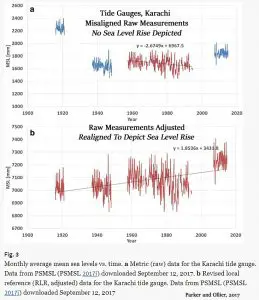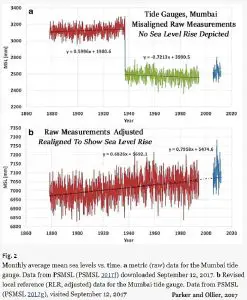
How much, and how fast, does sea level rise in the world? This is yet another field in the climate area where there are very divided opinions. Swedish Wikipedia writes as follows:
Global warming is expected to cause significant sea level rise in the next century. However, there are no clear and secure research results on how much it will be in the 50 or 100 year term. Therefore, the issue of sea level rise is highly controversial, not least because it is considered to be due to carbon dioxide emissions, which are linked to large economic and convenience values, for example in connection with road traffic.
Research has been done to calculate the sea level rise. Results range from 0.2 to 8 meters to 2100, depending on the model used. Based on historical changes, some researchers have made calculations that show a sea level rise of about 1.3 m during the 2000s. [6] [7] Another research team that tried to model the dynamic melting of the glaciers believes that about 0.8 m of sea level rise by the year 2100 is most likely.
Oops! Calculations of the sea level rise to 2100 thus vary between 0.2 and 8 meters! So it doesn’t usually sound like the “experts” in the media are saying. Then the highest numbers are many.
I will not try to give in to this whole complex scientific debate. We have rewritten it several times here on the climate information (for example, search at “sea level” in the blog’s search engine). But by chance, I read about an article by Parker & Ollier from 2017, “Is the Sealevel Stable at Aden, Yemen”, Earth Systems and Environment. Unfortunately, it costs 43.69 euros (around SEK 450) to read the article itself so I have to rely on secondhand descriptions.
The article is quite provocative as the authors accuse a well-known institution, the Permanent Service for Mean Sea Level (PSMSL), for manipulating measurements we have in three places around the Indian Ocean; Aden, Karachi and Mumbai. This is about fixed measuring stations at the coasts and you may think that these would be quite simple and impossible to manipulate. Unlike satellite measurements of the sea level (a simple description can be found here), these mareographs (called tide gauges), as they are called, stand on solid bedrock.
But it’s not that simple, of course. Instruments are broken, replaced or moved. And if you want to connect all measurement series to a coherent series, it will be a patch and fix together with guesses. And then it might look like this:

and this

Parker & Ollier is of the opinion that PSMSL has made its merging of measurement data in a wrong and tendentious way. They have consistently done so that all negative or flat trends disappear and are replaced by positive trends instead. But such adjustments do not match other measurements around the Indian Ocean. Rather, sea level elevations are unchanged or very small. And there is no acceleration whatsoever about it.
After all, we have become accustomed to the fact that the various climate institutions that measure soil-based warming in the atmosphere adjust and change the figures so that the temperature increases are in line with the increase in carbon dioxide. All in accordance with the notion that it is the carbon dioxide that drives the climate. Now it is a little worrying if even reliable PSML falls into a similar trixing with their measurement series.
Well. PSML warns that their adjustments are not arbitrary or tendentious at all. The results just happen to be as they become. Here the discussion quickly becomes quite technical and difficult to follow for a layman.
Parker & Ollier published a new article in 2019, “Pacific sea levels rising very slowly and not accelerating”. The article is free to download. So this time it’s all about the Pacific Ocean! In the abstract it says
The average relative rise and acceleration for the 29 long-term tidal gauges in Japan, Oceania and the West Coast of North America are both negative, −0.02139 mm year ⁻¹ and −0.00007 mm year ⁻². Since the beginning of the 20th century, sea levels in the Pacific have been remarkably stable.
We can thus conclude that the scientific controversy continues and that the researchers hardly exhibit the “consensus” on alleged advice. The political / media sphere and the scientific are really different worlds.
Leave a Reply